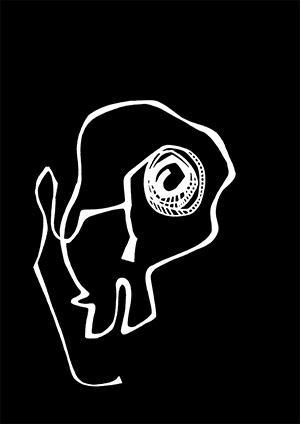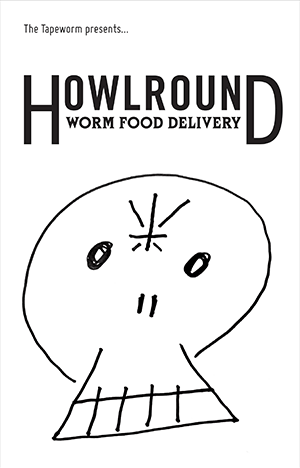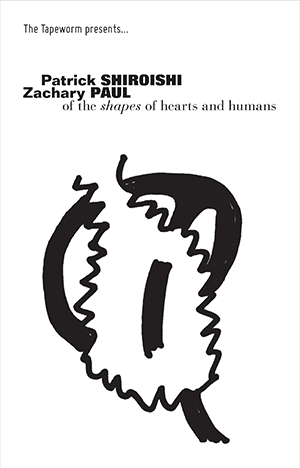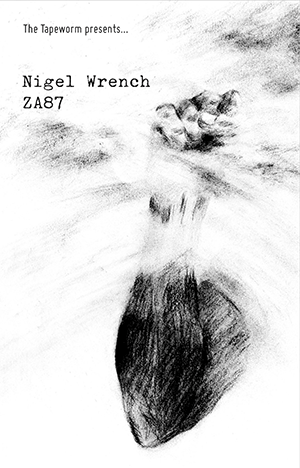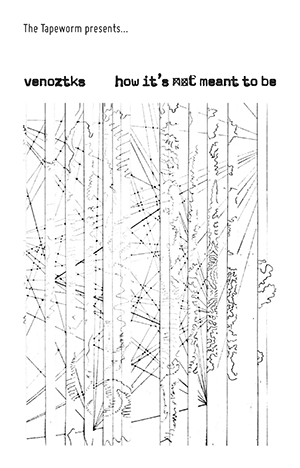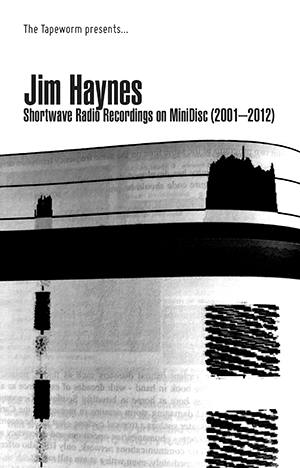Ken Hollings – Parasitic Infestation
The following essay was originally published in TBW#01 – “The Art of Worms” – The Bookworm’s first perfect paperback.
A live reading, recorded in October 2011 at our “Worm Eats Bear” soirée, can be heard on Ken Hollings’ edition for The Tapeworm, “Works For Magnetic Tape” (TTW#81). This recording was exclusively previewed in September 2015 on The Wire’s site. And then the tape’s release was delayed until 21st December 2015. Cross-platform promotion in motion, folks…
Parasitic Infestation – some notes on the audiocassette considered as a form of technological infection
“No, ‘They’ are not God or super technicians from outer space. Just technicians operating with well-known equipment and using techniques that can be duplicated by anybody else who can buy and operate this equipment.” William S. Burroughs, Electronic Revolution, 1971
Astronauts participating in NASA’s Apollo programme were allowed to take one audiocassette of music with them as part of their personal allocation on the long journey to the Moon and back. Most of them chose country and western recordings. A meeting of frontiers often marks the outer reach of a communicable condition: invariably the spread of civilisation is also accompanied by the spread of infectious diseases. Introduced in the early 1960s by the Dutch electronics company Philips, the compact audiocassette went on to revolutionise the transportation of recorded data. A light and self-contained assemblage of plastic and metal parts, it became the medium of total dispersal over the latter half of the twentieth century, infecting individuals and mass groupings alike. The audiocassette could not keep still even for a minute. Once a common sight along our roads and highways the streamers of thin black acetate unspooling from broken cassettes tossed out of speeding car windows gave some indication of not just its extreme mobility but its disposability as well. A cheap, mass-produced device designed to couple mechanically with other cheap mass-produced devices, the audiocassette could — and did — go everywhere and anywhere, extending its influence even into the zero-gravity realms of outer space. Throughout the 1980s and 1990s country rock continued to be played onboard the Space Shuttle as each mission went into orbit around the Earth. The mission, however, would now seem to be coming to an end.
Packs of blank C90s are increasingly hard to find on supermarket shelves; and the Sony Walkman, at one time the most perfect expression of the audiocassette’s range of influence, is no longer being manufactured. Look at the controls on either a CD or MP3 player, and the cassette machine’s presence can still be detected in the symbols they use: the square for stop, an isosceles triangle pointing to the right for play, double triangles indicating opposing directions for fast-forward and rewind, a red disk for record, and two parallel vertical bars for pause. These are the marks of an infection that can never be completely erased from our consciousness. They also illustrate the extent to which music has encouraged new forms of technological development. The two have continually been in an unstable relationship with each other since the time of the well-tempered keyboard; but with the mechanical reproduction of recorded sound, music has been transformed into an environment for incubating new technology. The audiocassette, in other words, belongs to a lengthening historical line of artefacts — which would include not only the microphone, the loudspeaker and the amplifier but also the home computer, the mobile phone and the games console — whose range of influence has been greatly extended through the personal listening habits of its consumers. An integrated arrangement of moving parts that is partly mechanical and partly electronic, the audiocassette runs music like a programme, bringing hardware and software closer together than they had ever been before. The simplified arrangement of buttons on both the PlayStation3 game pad and the Xbox controller reveal how the very concept of interactivity itself is just one more symptom of our progressively infected behaviour patterns.
Like any communicable disease, the audiocassette connected public with private space. By expanding the recording range and the sensitivity of magnetic tape during the 1950s and 1960s, it was possible to develop a recording and playback system for the home, where it was used for a widening number of activities from listening to music and learning foreign languages to preserving memories and taping radio broadcasts. As the open reel gave way to the closed cassette, the tape player became another pushbutton device in a domestic environment made up of thermostatic controls, timers, switches and dimmers; and just like them, it also helped set the mood. Colours, patterns and textures in the family living space grew more vivid and tactile, while plastic furniture, modular shelving and open-plan layouts invited further interactivity. The private utopias they helped to fashion out of the modern home interior reflected the broader social and cultural upheavals of the late 1960s and early 1970s, suggesting how liberalised attitudes towards bodies and pleasures were to be navigated in the coming decades. Such spaces became overloaded with information: music consequently became an accompaniment to seduction. Volume levels and sexual temperatures started to rise, provoking between them a controlled form of psychological instability. It was only in the domestic utopia of private space, after all, that people could learn to forget themselves. Meanwhile, far above this world, NASA’s astronauts continued to play their tapes of country music. True mobility, however, now began and ended in the living room.
Storage of data becomes more interactive in a domestic space. When it comes to how music in particular is stored, transmitted or delivered, format changes everything. Its impact upon our behaviour may be even more persistent and pervasive than the music itself. Back in the Space Age, when some of the more adventurous-minded architects and designers were predicting that the entire population of swinging London would soon be living in the pods, capsules and domes, the audiocassette, sealed inside its hard plastic shell, supplied the perfect soundtrack for this new mode of existence. The audio equivalent of astronaut food, it kept music freeze-dried and vacuum-packed for future consumption. Playing times became equally self-contained and standardised: the C60 and the C90 allowed programmes to run uninterrupted for up to thirty or forty-five minutes respectively, while the C46 was an attempt to accommodate the much more limited and irregular storage capacities of the highly popular long-playing record. This, however, was the kind of concession that a parasite might offer to a host before its inevitable invasion and takeover. Having established the parameters by which the faithful reproduction of recorded sound would transform music into a simulated version of itself, the 12-inch vinyl disc became the infected body upon which the C60 and the C90 both fed and increased. While the audiocassette may not have represented the industry standard for perfection in studio recording, it proved more than adequate for the task of copying that which had already been recorded. Companies like TDK, Maxell and Sony made huge profits selling blank cassettes — that is to say, recordings of absolutely nothing at all — for the public to fill with further simulations of an already simulated listening experience. Sometimes it became hard to tell the difference. Was it live, or was it Memorex? Only the shattering wine glass featured in the company’s advertising campaign knew for sure.
By the 1980s, the playback and recording capabilities of the audiocassette were being connected up to early home computers and telephone answering machines, thanks to the C10 and C15, and finally, with the introduction of the Sony Walkman, to the street itself. Programmes could now be loaded and stored, games run, and personal messages left for future access. It was, however, in the easy duplication of music, transferring it from vinyl onto cassette, that the biggest connection between public and private space was established. The Walkman ensured that not just your own listening experience but your entire record collection could now become completely mobile. Widespread viral replication seemed inevitable. The major players in the record industry tried to contain the infection: health warnings started to appear on the back of album covers in the form of a silhouetted cassette and cross bones above the stern admonition that ‘Home Taping Is Killing Music’. Killing vinyl the companies meant — and they weren’t right about that either.
Vinyl’s status was doomed to change radically the moment its limitations as a data-storage medium were exposed by the audiocassette’s versatility; audiobooks and magazines, plus taped transcriptions of conversations and other forms of documentation, helped transform the spoken word into something more free-flowing, spontaneous and accessible. Once language is changed, everything changes. The encrypting of data onto compact discs and flash drives follows patterns already established through the development of the audiocassette, from the storing and erasing of files to their transportation and distribution as ‘removable memory’. The audiovisual range may have been extended from words, music and sounds to capture images and texts as well, but adaptability remains a key element in the development and survival of every subsequent new format. Vinyl has consequently come to assume an aura of permanence usually reserved for our more cherished art works; meanwhile the audiocassette maintains a surreptitious viral presence in the digital regime — one that is neither here nor there, both anonymous and personal at the same time. A technological infection transforms whatever it touches, leaving its traces deep within the host’s body: all prospects of recovery seem temporary at best, illusory at worst. In the end the two become inseparable — a single entity whose wholeness and stability will last only until the next infestation occurs.
Ken Hollings, London, May 2011


